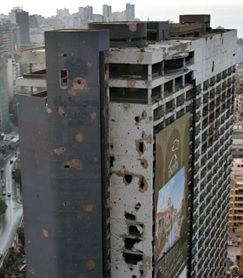My father was offered a job in Lebanon as an agricultural sciences instructor soon after graduation. In those days Lebanon was a peaceful country and its capital city, Beirut, was known as the Paris of the Middle East. Dad wanted to take the offer and move there. Mother convinced my father to accept a teaching position in Washington State instead. Sometimes growing up, especially in the dead of winter, my dad would become wistful about the sunny Mediterranean beaches of Lebanon.
I first traveled to Lebanon to work with business associates in Beirut. Not yet recovered enough from decades of war to be again considered the Paris of the Middle East, the place is still unique for its mix of European (mainly French) cultural influence, and the fact that Christians (Protestant, Maronite, Catholic and Druze), Muslims (Shiites and Sunnis) and a scattering of Jews, live side by side. Although there was once a thriving Jewish community in Beirut, Jews have largely abandoned the city, especially after the 1967 Arab Israeli War during which Israeli bombs damaged the historic synagogue in the Jewish quarter.
In Beirut, the various ethnic and religious groups have pretty much segregated themselves into quarters. While there were still low level conflicts between Sunni and Shiite when I was there, most problematic for the Lebanese government was the perimeter around the Christian quarter. Perimeter crossover from the neighboring Muslim area into the Christian quarter were marked by canvas awnings covering military vehicles, including armored personnel carriers. Soldiers in uniform armed with automatic rifles stationed at the main intersections pay close attention to vehicles, especially those entering into the Christian quarter.
My host lived in a Muslim district. While much more westernized and liberal than many colleagues in Saudi Arabia, for example, the fact that you are in the home of a Muslim is unmistakable. Close your eyes and the smell of the wood, the incense, fabrics and food, and the sound of the prayer call from the mosque down the street make you feel you could just as well be in Abu Dhabi, Dhahran, or Muscat.
Places of note in the city vary from the shell-riddled and abandoned 24 story Holiday Inn, left as a memorial of the war, to plentiful and varied Roman ruins, some converted to parks in the middle of downtown. One can be walking down a street past a section of the original Roman road excavated to 20 feet below street level and three blocks later be in front of an upscale European hotel with Lambos and Ferraris parked out front.
Walk down a few blocks from the mid-town Roman road and you find yourself among 19th Century colonnaded buildings passing high fashion shops and eateries. Looking down the street to the clock tower and you could be in Paris. Beirut is easily the most European and secular city in the Middle East. In the main downtown business districts and upscale shopping areas especially near the harbor, there is absolutely no hint of ethnic strife or discrimination. Everyone appears friendly and helpful.

But the image of Beirut that sticks in memory is the shell-riddled and abandoned Holiday Inn. Visible from most points in the city, it was occupied at different times by different local militias during the decades of intermittent war. This building was fought over on and off for more than 15 years. During the main conflict, the various occupying forces, in turn, stripped the building. Anything of value, including copper wire and plumbing in many cases, was carried it off for barter or sale.
The ruined and abandoned building is now fenced off with no entry allowed. Nonetheless, it is well known that the younger crowd sometimes sneak into the old hotel and hold parties on the roof. Because the foreign owners cannot agree on what should be done with it, the now infamous Holiday Inn stands as a stark reminder of the conflict and in contrast to the area around it that has been re-developed to an even more upscale and glitzy part of town.

During conversations over dinner in the home of my host, among crowds of younger Lebanese at a party on the roof top of my hotel overlooking the harbor, or in conversations with my driver, it soon became apparent that people there have little interest in talking about the decades of what now seems, to foreigners at least, like senseless conflict. The troubles in Lebanon were as complicated as they are well documented on the internet and in books. Each of the many sides involved over the years has their own version. And now, in 2020, it appears that Hezbollah and the Lebanese government may be about to go at it again.
On my last day there I asked my driver, “What the hell were they fighting about all these years?"
His answer - “Religion mostly.”

